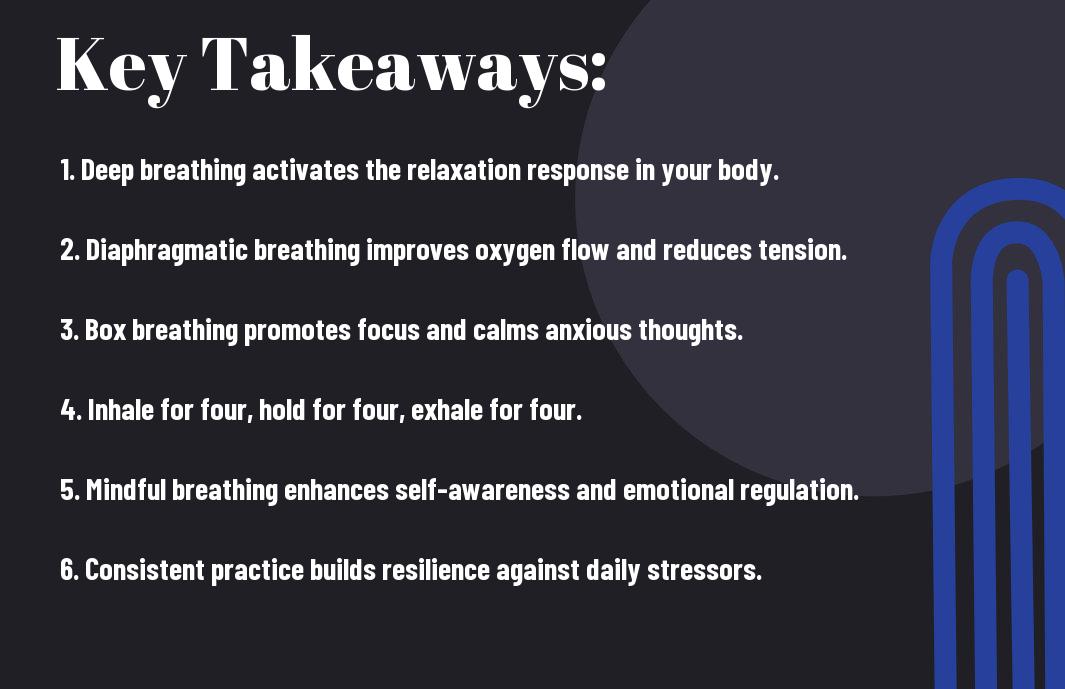Stress can take a significant toll on both your mental and physical well-being, making it important to have effective strategies at hand. One powerful way to manage stress is through breathing techniques that promote relaxation and mindfulness. By integrating these methods into your daily routine, you can harness the calming power of your breath to alleviate tension and enhance your overall sense of balance. Explore these techniques to find what works best for you, and transform your approach to stress management starting today.

Key Takeaways:
- Breath Control: Learning to control your breath can improve your emotional and physical well-being.
- Deep Breathing: Techniques such as diaphragmatic breathing help activate the body’s relaxation response.
- Mindfulness: Incorporating mindfulness into breathing exercises enhances focus and reduces anxiety.
- Regular Practice: Consistent practice of breathing techniques can lead to long-term stress reduction benefits.
- Accessible Techniques: These methods can be practiced anywhere, making them convenient tools for stress management.
- Increased Awareness: Stress-reducing breathing encourages heightened awareness of your body’s responses to stress.
- Physical Benefits: Proper breathing can lower heart rate and blood pressure, promoting overall health.
Understanding Stress and Its Effects
The impact of stress on your body and mind can be profound. It triggers a series of physiological responses, leading to various health issues if left unaddressed. Chronic stress can affect your sleep, relationships, and overall well-being, making it vital to recognize and manage it effectively to maintain your quality of life.
The Physiology of Stress
Between your brain and body, a complex interplay unfolds when you experience stress. Your hypothalamus activates the adrenal glands, releasing stress hormones like cortisol and adrenaline. This response prepares you for a fight-or-flight situation, but when stress becomes chronic, it can lead to health complications, including elevated blood pressure and weakened immune response.
Mental Health Implications
At the emotional level, stress can lead to anxiety, depression, and a host of other mental health challenges. The way you perceive and respond to stress significantly influences your mood and cognitive function, affecting everything from motivation to decision-making.
With ongoing stress, your mental health may deteriorate further, making it harder to cope with everyday challenges. You might find yourself feeling overwhelmed or unable to concentrate, which can create a cycle of negative thinking and increased anxiety. Prioritizing stress management strategies is imperative for maintaining not just emotional well-being but also enhancing your overall quality of life.

The Science of Breathing
Clearly, understanding the science of breathing can enhance your stress-reduction efforts. Breathing is not just a physiological function; it can significantly influence your mental state. By practicing specific techniques, you activate the parasympathetic nervous system, promoting relaxation. To explore practical methods, check out these 3 breathing exercises to relieve stress.
How Breathing Affects the Body
Below, you will discover how your breath directly impacts your body. Controlled breathing can lower your heart rate, reduce blood pressure, and enhance oxygen supply. This not only improves physical health but also creates a more balanced emotional state, helping you manage stress and anxiety effectively.
The Connection Between Breath and Mind
Beside the physiological benefits, your breath plays a pivotal role in your mental health. Your breathing pattern can influence your emotions, shaping how you react to stressors in your daily life. By learning to control your breath, you can attain a calmer mind and more focused thoughts.
Understanding the connection between breath and mind enables you to harness the power of breathing for emotional regulation. When you experience stress, your breath often becomes rapid and shallow, leading to a fight-or-flight response. By consciously slowing your breath, you activate a sense of calm and signal your brain that it’s safe to relax. Knowing this, you can intentionally use breathing techniques to shift your mental state and improve your response to challenges.
Basic Stress-Reducing Breathing Techniques
To manage stress effectively, incorporating simple breathing techniques into your daily routine can be beneficial. Techniques like deep and rhythmic breathing help calm your mind and body, allowing you to regain focus and tranquility. For more insight into these methods, check out this resource on Breathing Techniques for Stress Relief.
Diaphragmatic Breathing
For effective stress reduction, diaphragmatic breathing, also known as abdominal or belly breathing, is an excellent technique. It involves inhaling deeply through your nose, allowing your diaphragm to expand fully, and exhaling through your mouth. This method enhances oxygen flow, leading to relaxation and a decrease in anxiety levels.
4-7-8 Breathing Method
Against a backdrop of hectic daily life, the 4-7-8 breathing method serves as a powerful tool to restore your calm. This technique requires you to inhale for four counts, hold your breath for seven counts, and exhale slowly over eight counts. This rhythmic pattern not only slows your heart rate but also helps regulate stress hormones.
The 4-7-8 breathing method is easy to practice and can be done anywhere. With regular use, this method can transform your response to stress, offering immediate relaxation. By focusing on counting and the rhythm of your breath, your mind shifts away from overwhelming thoughts, providing a sense of control and serenity.

Advanced Breathing Techniques
Once again, exploring advanced breathing techniques can enhance your relaxation and stress management skills. These methods help you connect deeper with your breath and find balance in your daily life. Below are some exceptional techniques you can incorporate into your routine:
| Technique | Description |
|---|---|
| Box Breathing | A structured technique involving equal breath phases for increased focus. |
| Alternate Nostril Breathing | A calming method that harmonizes your mind and body. |
Box Breathing
One effective method, known as box breathing, involves inhaling, holding, exhaling, and pausing each for the same count of four. This practice can help you regain focus and tranquility during chaotic moments, as it encourages you to take control of your breath.
Alternate Nostril Breathing
Breathing through alternate nostrils balances the body’s energies, promoting relaxation and mental clarity. By closing one nostril at a time while inhaling and exhaling, you can achieve a calming equilibrium that is beneficial for stress relief.
It creates a rhythmic flow, allowing you to focus your mind and regulate your breath. This technique enhances overall well-being as it calms your nervous system, enabling you to ground yourself even in the busiest moments of your day. Aim to incorporate this practice regularly for the best results.

Incorporating Breathing Techniques into Daily Life
Keep breathing techniques accessible by integrating them into your daily routine. You can practice deep breathing while sitting at your desk, waiting in line, or even during your commute. By making these techniques a natural part of your day, you’ll find it easier to maintain a sense of calm and focus, enriching your overall well-being.
Creating a Practice Routine
Practice setting aside dedicated time each day to focus on your breathing exercises. This can be as little as five minutes in the morning or before bed. Consistency is key; you may find that establishing a specific routine helps solidify the habit and forms a valuable cornerstone of your stress management strategy.
Mindfulness and Breathing
On incorporating mindfulness into your breathing practices, aim to enhance your awareness of each breath. By concentrating on how the air moves in and out of your body, you can ground yourself in the present moment and alleviate overwhelming thoughts. This not only promotes relaxation but also strengthens your ability to manage stress effectively.
A successful mindfulness practice involves tuning into your breath and observing your thoughts without judgment. While practicing, find a comfortable position and focus on the rhythm of your breathing. Notice the sensations in your body as you breathe in and out. If your mind wanders, gently guide your focus back to your breath, fostering a calmer and clearer state of mind. This can profoundly impact your mental resilience and stress management over time.
Benefits of Regular Practice
Despite the chaotic nature of daily life, incorporating regular breathing techniques into your routine can yield significant benefits. By dedicating just a few minutes each day to practice, you can enhance your ability to manage stress effectively, maintain emotional balance, and foster a greater sense of control over your reactions. Consistent practice not only builds resilience but also empowers you to navigate life’s challenges with increased clarity and calmness.
Long-Term Stress Reduction
Long-term practice of breathing techniques enhances your overall stress resilience. As you engage in these exercises regularly, your body learns to respond to stress triggers more effectively, reducing the physiological and emotional toll of stress. This ongoing process helps you maintain a more stable mood and a stronger sense of well-being in the long run.
Improved Overall Well-Being
With a commitment to regular breathing exercises, you’ll likely notice an improvement in your overall well-being. These practices can lead to enhanced mental clarity, better sleep quality, and reduced anxiety levels. As you cultivate this positive change, you may find yourself better equipped to handle daily challenges, leading to a more fulfilling and productive life.
Overall, improved well-being from consistent breathing practices extends beyond immediate stress relief. You may find an increase in motivation, a boost in creativity, and an enhanced ability to focus on tasks. Your relationships may also benefit as your emotional responses become more balanced and thoughtful, fostering deeper connections with those around you. Prioritizing these exercises equips you with practical tools for navigating your personal and professional life more effectively.
To wrap up
Hence, incorporating stress-reducing breathing techniques into your routine can significantly enhance your well-being. By practicing these techniques, you can create a sense of calm and control in your everyday life. Focusing on your breath not only helps you manage stress but also promotes relaxation and improves your overall mental clarity. Make a commitment to engage in these practices regularly and observe how they positively impact your emotional and physical health.
FAQ about Stress-Reducing Breathing Techniques
Q: What are stress-reducing breathing techniques?
A: Stress-reducing breathing techniques refer to various methods that leverage the power of breathing to promote relaxation and alleviate stress. These techniques often focus on slow, deep, and rhythmic breathing patterns to help calm the nervous system and enhance emotional well-being.
Q: How can I incorporate breathing techniques into my daily routine?
A: To incorporate breathing techniques into your daily routine, set aside a few minutes each day for practice. You can start by finding a quiet space, sitting or lying down comfortably, and focusing on your breath. Consider setting a specific time, such as in the morning or before bed, to establish a consistent practice.
Q: What are some popular breathing techniques for reducing stress?
A: Some popular breathing techniques for reducing stress include Diaphragmatic Breathing, Box Breathing, 4-7-8 Breathing, and Alternate Nostril Breathing. Each method has unique patterns and focuses, but all aim to foster relaxation and decrease anxiety levels.
Q: How does deep breathing help with stress relief?
A: Deep breathing helps with stress relief by activating the body’s relaxation response. This process reduces heart rate and lowers blood pressure, which counteracts the stress response. As a result, deep breathing can help shift the body from a state of stress to one of calmness and serenity.
Q: Can breathing techniques be used during stressful situations?
A: Yes, breathing techniques can be effectively used during stressful situations. Practicing deep or focused breathing when feeling overwhelmed can help center your thoughts and improve your emotional response, enabling you to handle the situation with greater ease and clarity.
Q: How long does it take to see benefits from breathing techniques?
A: Individuals may experience benefits from breathing techniques almost immediately, often feeling a sense of calm after just a few minutes of practice. However, the cumulative effects of consistent practice over time may lead to more significant stress reduction and overall well-being.
Q: Are there any risks associated with breathing techniques?
A: Generally, breathing techniques are safe for most individuals. However, those with respiratory conditions or other health issues should consult a healthcare provider before starting a new breathing practice. It’s important to listen to your body and stop if you feel any discomfort.



